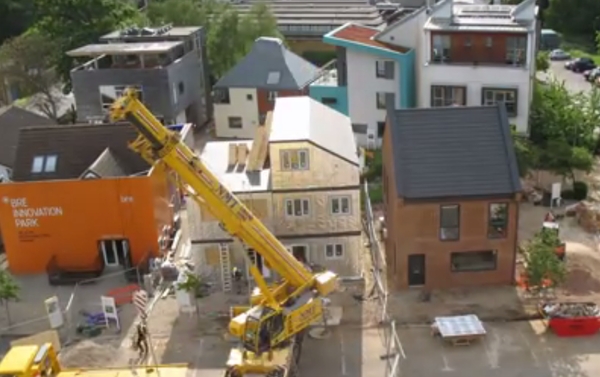BRE Üserhuus
The BRE Innovation Park in Watford was created in 2005 to test and demonstrate the buildings of the future. It is home to some of the world’s most sustainable buildings, landscape designs and low carbon materials and technologies.
In September 2015, BRE launched two new demonstration housing units brought to market by Üserhuus AG and Tigh Grian Ltd, which they describe as ‘affordable, energy-efficient, quick to build volumetric housing solutions’. They are built to the Scottish Building Regulations Gold Standard and are intended to demonstrate the potential of super-efficient, factory-finished, configurable dwellings.
[Image links to YouTube footage of the installation process]
The volumetric units were factory built in Wales, including services, fittings and decoration. The 4.9m x 11.4m modules were then transported by lorry to be laid on pre-prepared foundations. They can be assembled into units of up to five storeys in detached, terraced, tenement, semi-detached and four-in-a-block configurations.
The units use a structural insulated panel system (SIPs) and include a whole-house mechanical heat recovery ventilation (MHVR) system, with wall-mounted electric panel heaters and achieve an EPC (Energy Performance Certificate) B rating.
The standard house types aim to deliver energy bills estimated at £300-500 per annum for energy and space heating, and with the addition of a building-integrated, photovoltaic “terra cotta” roof can produce supplementary energy.
The units cost less than £1000 per square meter, and, being prefabricated, can be ready for occupation sooner than traditional housing, generating an early revenue stream for developers.
Director of the BRE Innovation Park Dr David Kelly said, ‘We have a chronic shortage of housing in the UK – we need to deliver 250,000 homes a year to meet market demand – last year we managed 118,000, less than half. We need to find new and better ways to deliver and these homes are a step in the right direction.
What is really impressive about the home aside from its affordability and sustainability is that it reduces end to end construction time by half, so 8 weeks from factory to completion on site – currently the average home takes a minimum of 16 weeks to build. This approach could really help us make significant progress with volume delivery.’
Dr. Stephen Wittkopf, Managing Director, Üserhuus AG, commented ‘The future of architectural design lies with the integration of renewable energy technologies. The project on the BRE Innovation Park is showcasing a first-in-the-UK integrated, terracotta style cladding and roofing PV system which points the way for future housing – we are looking forward to seeing how it performs….’
The Üserhuus/Tigh Grian concept has been commissioned for use on a 50 unit housing development in Alva Scotland, with construction starting later in 2015.
--BRE.
[edit] Related articles on Designing Buildings Wiki
- Building Research Establishment.
- BRE articles on Designing Buildings Wiki.
- BRE Watford Innovation Park.
- Design for deconstruction, BRE modular show house.
- Energy Performance Certificate.
- Kit house.
- Modular building.
- Prefabrication.
- WikiHouse.
- Y:Cube development in Mitcham.
- Y:Cube.
[edit] External references.
Featured articles and news
Latest Build UK Building Safety Regime explainer published
Key elements in one short, now updated document.
UKGBC launch the UK Climate Resilience Roadmap
First guidance of its kind on direct climate impacts for the built environment and how it can adapt.
CLC Health, Safety and Wellbeing Strategy 2025
Launched by the Minister for Industry to look at fatalities on site, improving mental health and other issues.
One of the most impressive Victorian architects. Book review.
Common Assessment Standard now with building safety
New CAS update now includes mandatory building safety questions.
RTPI leader to become new CIOB Chief Executive Officer
Dr Victoria Hills MRTPI, FICE to take over after Caroline Gumble’s departure.
Social and affordable housing, a long term plan for delivery
The “Delivering a Decade of Renewal for Social and Affordable Housing” strategy sets out future path.
A change to adoptive architecture
Effects of global weather warming on architectural detailing, material choice and human interaction.
The proposed publicly owned and backed subsidiary of Homes England, to facilitate new homes.
How big is the problem and what can we do to mitigate the effects?
Overheating guidance and tools for building designers
A number of cool guides to help with the heat.
The UK's Modern Industrial Strategy: A 10 year plan
Previous consultation criticism, current key elements and general support with some persisting reservations.
Building Safety Regulator reforms
New roles, new staff and a new fast track service pave the way for a single construction regulator.
Architectural Technologist CPDs and Communications
CIAT CPD… and how you can do it!
Cooling centres and cool spaces
Managing extreme heat in cities by directing the public to places for heat stress relief and water sources.
Winter gardens: A brief history and warm variations
Extending the season with glass in different forms and terms.
Restoring Great Yarmouth's Winter Gardens
Transforming one of the least sustainable constructions imaginable.
























